The Paralympic Games are more than just a sporting event—they are a testament to human strength, innovation, and the relentless pursuit of excellence. Over the years, Paralympic athletes have shattered records, defied expectations, and redefined what is possible in adaptive sports. But behind their success lies a revolution in sports prosthetics, where cutting-edge technology meets the determination of world-class competitors.
Sports prosthetics today are lighter, faster, and more responsive than ever before. Designed to match the specific needs of different sports, they allow athletes to sprint, jump, swim, and compete at elite levels. Engineers and prosthetists work closely with athletes to fine-tune every detail, from blade stiffness and alignment to socket fit and weight distribution, ensuring optimal performance.
Paralympians are not just using prosthetics—they are actively shaping their development. Their feedback drives innovation, pushing the limits of biomechanics and material science to create prosthetics that offer even greater efficiency, comfort, and power. In this article, we explore how Paralympic athletes are transforming the world of sports prosthetics and what it means for the future of adaptive sports.
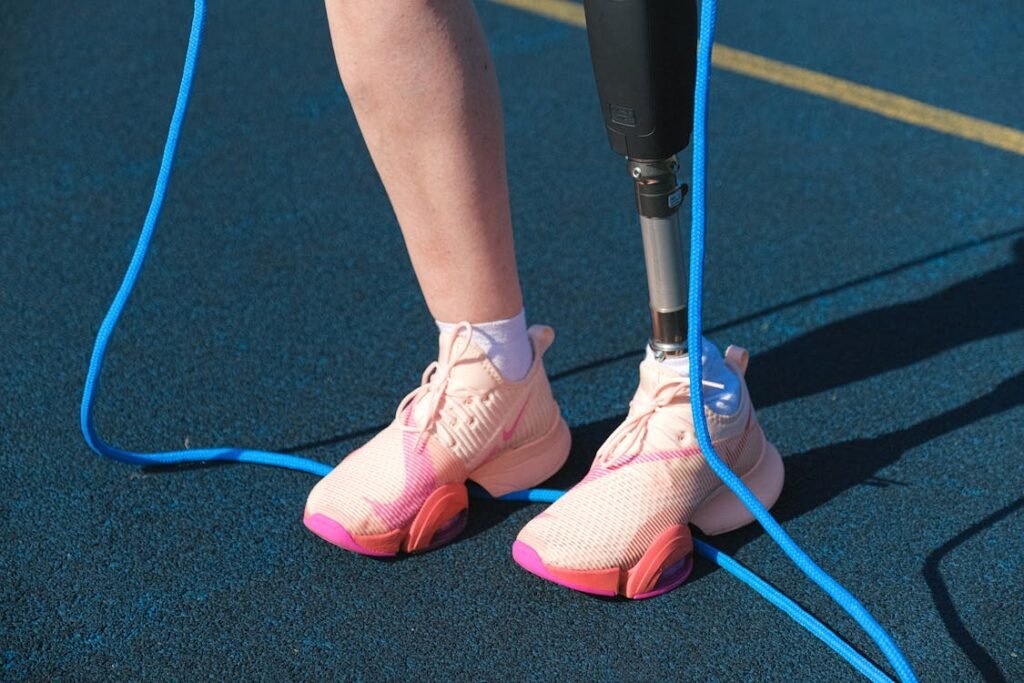
The Evolution of Sports Prosthetics in the Paralympics
The journey of sports prosthetics has been a remarkable one. In the early days, prosthetic limbs were designed primarily for basic mobility, with little focus on high-performance athletics. Athletes had to adapt to heavy, rigid prosthetics that were more functional than efficient.
As the Paralympic movement grew, so did the demand for better prosthetic technology. Engineers began experimenting with carbon fiber, lightweight alloys, and energy-return designs, creating prosthetics that could withstand the demands of intense physical activity.
By the late 20th century, the introduction of running blades and sport-specific prosthetic designs changed the game, allowing athletes to compete at speeds and levels of agility previously thought impossible.
Today, sports prosthetics are custom-built for each athlete. Every detail—from the flexibility of the blade to the way it absorbs impact—is engineered to maximize speed, endurance, and stability.
The result? Paralympic athletes are setting new world records and proving that adaptive technology can rival, and in some cases surpass, biological limbs in performance.
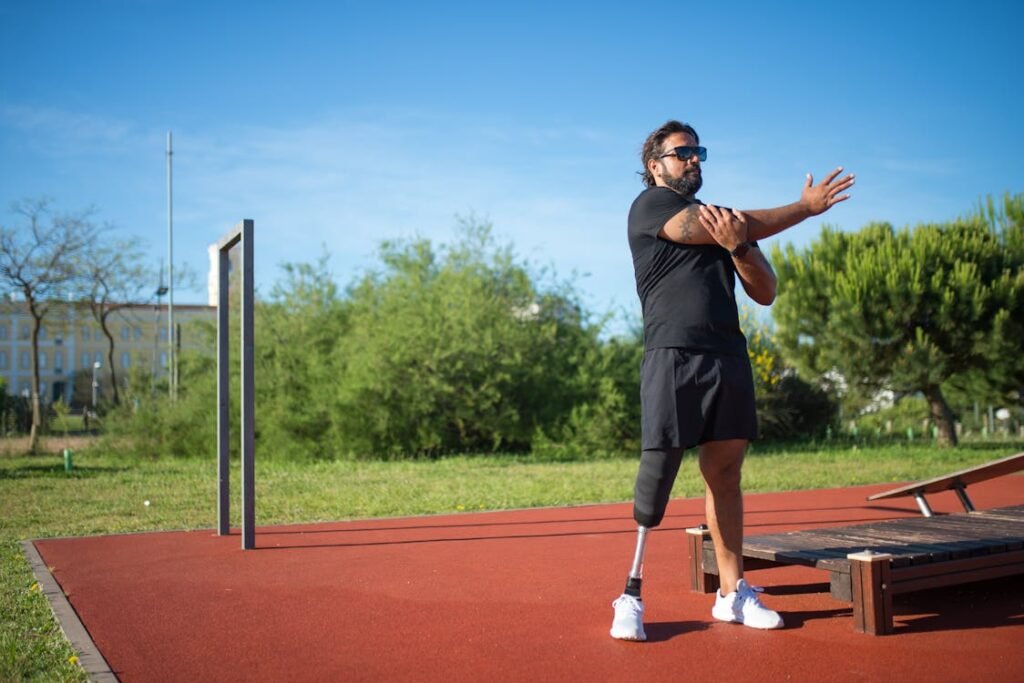
How Paralympians Are Redefining Performance with Advanced Prosthetics
Paralympic athletes are proving that sports prosthetics are not just replacements for lost limbs—they are high-performance tools designed to enhance speed, agility, and endurance.
Through years of rigorous training, technological refinements, and biomechanical adaptation, these athletes have developed a unique relationship with their prosthetics, allowing them to push beyond conventional physical limits.
Running Blades: Speed and Precision in Motion
One of the most iconic advancements in sports prosthetics is the running blade. These carbon-fiber blades, designed for maximum energy return, allow athletes to sprint at incredible speeds.
Unlike traditional prosthetic feet, which are built for stability, running blades work like a spring, storing energy on impact and releasing it for propulsion.
Paralympic sprinters train intensively to master the mechanics of blade running. Unlike natural legs, which generate force through muscle contractions, running blades rely on timing, weight distribution, and controlled movement.
Athletes must fine-tune their technique to harness the blade’s energy efficiently, ensuring each stride is explosive and balanced.
The design of running blades continues to evolve. Engineers work with athletes to optimize stiffness, length, and curve based on their weight, running style, and competition category.
The result? Faster sprint times, more efficient strides, and record-breaking performances on the track.
Jumping with Prosthetics: Defying Gravity
Paralympic athletes in long jump and high jump events face unique challenges. Jumping requires precise force distribution, takeoff power, and mid-air control, all of which depend on how well an athlete interacts with their prosthetic limb.
Unlike a biological leg, which can generate force through muscle contraction, a prosthetic relies entirely on blade tension and rebound mechanics.
Athletes use prosthetics with extra curvature and reinforced energy-return systems, allowing them to absorb force on landing and spring forward with minimal energy loss.
The alignment of the blade also plays a critical role—minor adjustments in angle and stiffness can mean the difference between clearing a record-breaking height or falling short of the mark.
Long jump Paralympians, such as Markus Rehm, have demonstrated that a well-optimized prosthetic can rival the efficiency of a natural leg, raising questions about whether prosthetic-enhanced performance might one day surpass human anatomical limits.
Swimming with Prosthetics: Overcoming Resistance in Water
Swimming presents a different challenge for Paralympic athletes. Water resistance affects movement differently than land-based sports, requiring prosthetics that minimize drag while maximizing propulsion.
Traditional prosthetic limbs, designed for walking or running, are not suited for aquatic movement, so specialized prosthetic designs for swimming have emerged.
Swimmers use prosthetics with hydrodynamic shapes that allow for smoother strokes and adjustable buoyancy to maintain balance. Some models include angled foot plates or flipper-like extensions to improve thrust, helping swimmers generate power efficiently.
Amputee swimmers must also adjust their stroke technique to account for the difference in propulsion between their prosthetic limb and natural limb.
Training focuses on refining body rotation, core stability, and arm movement, ensuring that every part of their body contributes to forward momentum.
Cycling with Prosthetic Adaptations: Power and Stability
Paralympic cyclists use prosthetics designed to deliver maximum pedaling efficiency. Unlike running or jumping, where energy return is key, cycling prosthetics prioritize rigid power transfer and joint stability.
Cyclists require a setup that allows them to generate force without losing energy through excess movement.
A well-designed cycling prosthetic includes adjustable footplates, reinforced sockets, and rotational alignment systems. The position of the prosthetic foot in relation to the pedal is crucial—minor misalignments can cause inefficiencies or strain the knee and hip joints.
Training for cycling with a prosthetic also involves optimizing cadence and power output, ensuring that both the natural and prosthetic side of the body contribute equally.
Some Paralympic cyclists use customized suspension systems to absorb road vibrations, reducing fatigue over long-distance races.
At Robobionics, we work closely with athletes to develop high-performance sports prosthetics tailored to their specific needs. Whether it’s running, jumping, swimming, or cycling, our cutting-edge designs ensure maximum efficiency, comfort, and durability.
If you’re looking for a prosthetic that can match your athletic ambitions, contact us today to explore your options.
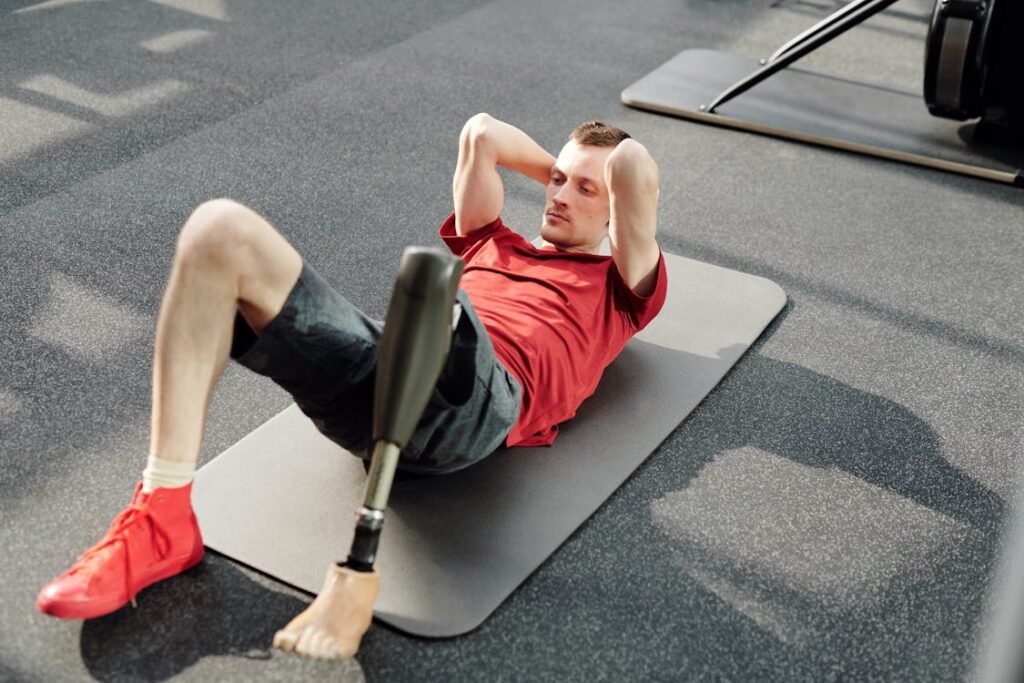
The Intersection of Human Biomechanics and Prosthetic Engineering
Paralympic athletes are not only transforming the way we view disability in sports but also challenging engineers and scientists to push the boundaries of prosthetic design.
The evolution of sports prosthetics is a result of a deep understanding of human biomechanics, material science, and engineering precision.
By analyzing how the body moves and interacts with a prosthetic limb, researchers can create more responsive, energy-efficient, and adaptive prosthetics tailored to high-performance athletics.
Biomechanics: Understanding Movement for Peak Performance
Biomechanics is at the heart of every sports prosthetic. Unlike standard prosthetic limbs designed for walking, sports prosthetics must account for the physics of speed, force absorption, and energy transfer.
Every sport has unique movement patterns, and prosthetics must be engineered to enhance rather than hinder performance.
For instance, in sprinting, an able-bodied athlete relies on their Achilles tendon and calf muscles to generate power.
A Paralympic sprinter with a running blade must use their hips, glutes, and core strength to compensate for the absence of active lower-leg muscles.
The design of the running blade must mimic the stored energy function of tendons, allowing for maximum propulsion with each step.
Similarly, in jumping events, biomechanics experts analyze takeoff angles, knee flexion, and landing impact to create prosthetics that can handle extreme forces.
The goal is to design a blade that allows for quick energy loading and explosive release, just like a biological leg would do during a jump.
Material Science: The Quest for Strength and Flexibility
Sports prosthetics must strike a balance between being lightweight for speed and strong enough to withstand repetitive impact. This is where material science plays a crucial role.
Carbon fiber remains the gold standard in sports prosthetics due to its ability to flex under pressure and return to its original shape without losing energy.
Unlike traditional materials like plastic or metal, carbon fiber is layered and shaped precisely to control stiffness and flexibility.
Engineers can adjust the thickness and orientation of the fibers to create prosthetics that are either rigid for power transfer (as seen in cycling) or flexible for dynamic movement (as seen in running and jumping).
Advancements in nanotechnology and composite materials are also shaping the next generation of prosthetics. Researchers are experimenting with reinforced polymers, adaptive smart materials, and bio-integrated designs that can adjust stiffness based on activity level.
This means that future prosthetics might be able to automatically adapt to different running speeds, terrain changes, or even body fatigue, giving athletes more control over their performance.
Precision Engineering: Customization for Every Athlete
No two athletes are the same, and neither are their prosthetic needs. Precision engineering allows prosthetists to custom-fit every component of a prosthetic limb to match the athlete’s body mechanics, sport, and personal preferences.
Athletes undergo detailed motion analysis, where cameras, force plates, and sensors track their stride, balance, and energy efficiency.
This data helps engineers fine-tune the blade stiffness, socket alignment, and weight distribution, ensuring that the prosthetic feels like a natural extension of the body.
In Paralympic training facilities, athletes work closely with engineers to test different configurations and adjust their prosthetics in real-time.
The smallest modifications—such as changing the angle of a running blade by a few degrees—can result in significant performance improvements.
At Robobionics, we believe that the future of sports prosthetics lies in precision customization and advanced material technology. Our mission is to provide athletes with prosthetics that enhance performance, reduce fatigue, and improve overall comfort.
If you’re looking for a high-performance prosthetic built for your sport, schedule a consultation with us today and take your game to the next level.

Breaking Barriers: The Impact of Paralympic Athletes on Prosthetic Innovation
Paralympic athletes are not just using advanced sports prosthetics—they are actively shaping their development. Every time an athlete competes, trains, or provides feedback on their prosthetic, they contribute to the next generation of innovation.
Their real-world experiences help engineers refine designs, improve functionality, and create prosthetics that are even more powerful, efficient, and adaptive.
Athlete-Driven Innovation: How Paralympians Shape Technology
No one understands the demands of a sports prosthetic better than the athletes who use them daily. Paralympic athletes work closely with engineers, providing critical insights into comfort, weight distribution, and energy return.
Their feedback leads to small but crucial changes in blade stiffness, socket fit, and suspension systems, allowing for even greater performance gains.
For instance, many sprinters report that blade flexibility can make or break their performance. If a blade is too stiff, it won’t compress enough to store energy, leading to a loss of propulsion.
If it’s too flexible, it may absorb too much impact, slowing the runner down. By fine-tuning these factors through athlete testing and biomechanical analysis, engineers can create blades that offer the perfect balance of shock absorption and energy return.
Similarly, in cycling, Paralympic athletes have influenced the development of prosthetic pedals and socket designs that enhance power transfer.
Since pedaling efficiency is all about minimizing wasted energy, newer cycling prosthetics focus on improving rotational alignment to ensure maximum force goes into every pedal stroke.
The Debate Over Prosthetic Advantage in Sports
As sports prosthetics become more advanced, the question of fair competition arises. Some critics argue that running blades and other high-performance prosthetics could give athletes an unfair advantage over those with biological limbs.
This has sparked controversy in international competitions, with governing bodies conducting studies to determine whether advanced prosthetics provide mechanical benefits beyond human capabilities.
One of the most famous cases involved Paralympic sprinter Oscar Pistorius, who competed against able-bodied athletes in the Olympics.
Researchers studied whether his carbon-fiber running blades allowed him to use less energy than a natural-legged runner. While studies concluded that his prosthetics didn’t provide a clear advantage, the debate raised important questions about the role of technology in sports.
Despite this, many experts argue that Paralympic athletes still face unique challenges that able-bodied competitors do not. Running with a blade, for example, requires higher energy expenditure due to the lack of muscle-driven control.
Athletes must adjust their form, develop extreme core strength, and train their bodies to move efficiently with their prosthetic.
Expanding Accessibility: Making High-Performance Prosthetics Available to More Athletes
One of the biggest challenges in sports prosthetics is accessibility. High-performance prosthetic limbs, especially custom-built models for elite sports, can be expensive and difficult to obtain.
Many aspiring Paralympic athletes struggle to find funding for the latest technology, limiting their ability to compete at the highest level.
Organizations, sponsors, and prosthetic manufacturers are now working to make sports prosthetics more affordable and widely available.
Through sponsorship programs, grants, and advancements in cost-effective manufacturing, more athletes are getting access to the tools they need to compete.
At Robobionics, we believe that every athlete deserves a chance to push their limits. Our mission is to develop affordable, high-performance sports prosthetics that empower users to achieve their athletic goals.
If you’re an athlete looking for a cutting-edge prosthetic, contact us today to explore our customized solutions.
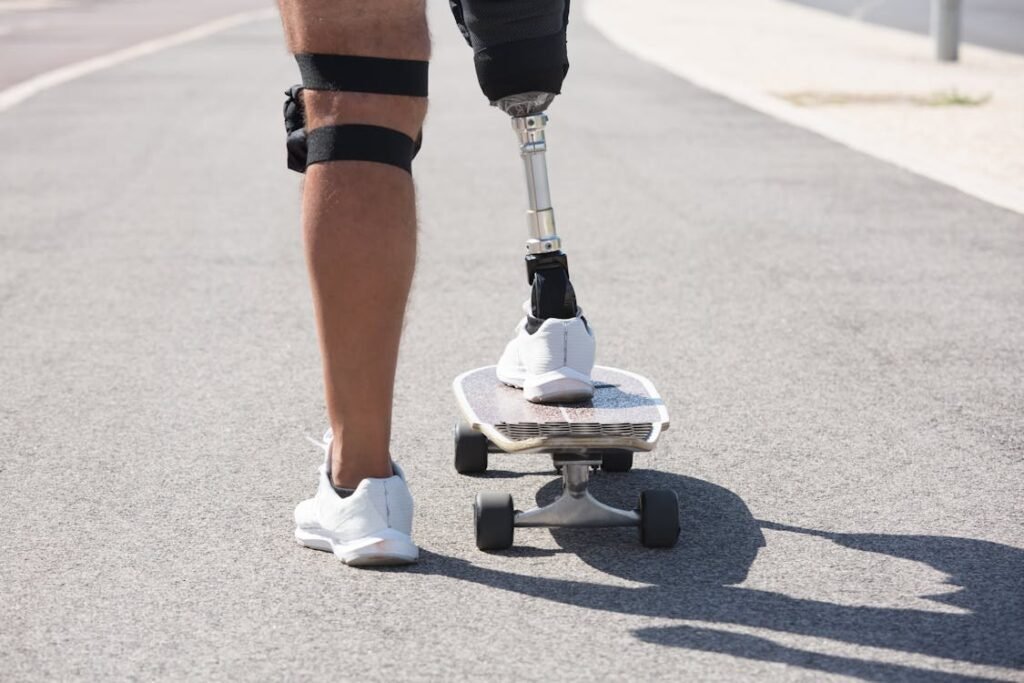
The Future of Sports Prosthetics: Where Innovation is Headed
Paralympic athletes have already revolutionized sports prosthetics, but the future promises even greater advancements.
As technology evolves, prosthetic limbs will become smarter, lighter, and more adaptable, allowing athletes to break new records and compete at even higher levels.
Researchers, engineers, and athletes are working together to push the boundaries of what sports prosthetics can achieve.
Smart Prosthetics: The Rise of AI and Sensor Technology
The next generation of sports prosthetics will integrate artificial intelligence (AI) and real-time sensor feedback to improve performance.
Current prosthetics rely on passive energy return, meaning they function purely based on physics and material properties. However, smart prosthetics will actively adjust based on the user’s movement, sport, and real-time conditions.
For example, a smart running blade could use embedded pressure sensors to analyze stride efficiency and make automatic stiffness adjustments mid-race.
This would allow an athlete to adapt their blade’s flexibility for different phases of a race—using a softer setting at the start for acceleration and a stiffer setting in the final stretch for maximum propulsion.
Some experimental prosthetics already use microprocessors to adjust damping and resistance, helping athletes control movement more precisely.
As AI technology advances, prosthetic limbs could eventually learn from an athlete’s running style, optimizing settings automatically for the best possible performance.
Lightweight and Ultra-Durable Materials
While carbon fiber has been the dominant material in sports prosthetics, researchers are developing even stronger and lighter alternatives.
Future prosthetic limbs could use graphene-infused composites, titanium-based alloys, or even bioengineered materials that mimic human tendons and muscles.
One major focus is improving impact resistance and flexibility. Running blades, for example, endure extreme stress with every step.
New materials that provide greater energy absorption without adding weight will allow for smoother, more powerful strides. Additionally, future prosthetics might incorporate self-repairing materials, reducing wear and tear and increasing longevity.
Fully Customizable and 3D-Printed Prosthetics
Advancements in 3D printing technology are making it possible to create fully customizable prosthetics at a much lower cost.
Instead of mass-producing standard prosthetic limbs, athletes could have personalized prosthetics tailored to their exact biomechanics, weight, and sport.
3D printing also allows for rapid prototyping, meaning athletes and engineers can test different designs quickly and make real-time modifications.
This could lead to prosthetic limbs that are perfectly adapted to an individual athlete’s movement style, giving them the best possible performance on the track, field, or court.
Bionic Prosthetics: The Next Frontier
The most futuristic development in sports prosthetics is bionic technology, where prosthetic limbs function more like biological ones.
Researchers are exploring ways to integrate nerve-controlled prosthetics that respond to brain signals, allowing for greater precision, control, and natural movement.
While bionic prosthetics are still in early development, they have the potential to transform adaptive sports. Imagine a prosthetic that responds instantly to muscle contractions, allowing for real-time adjustments in running, jumping, or cycling.
The potential for enhanced performance through neuromuscular integration could one day bridge the gap between artificial and biological limbs entirely.
At Robobionics, we are constantly innovating to stay ahead of these advancements. Our goal is to bring the latest sports prosthetic technology to athletes, helping them achieve their full potential.
If you’re interested in the future of prosthetics and how it can improve your performance, reach out to us today for a consultation.
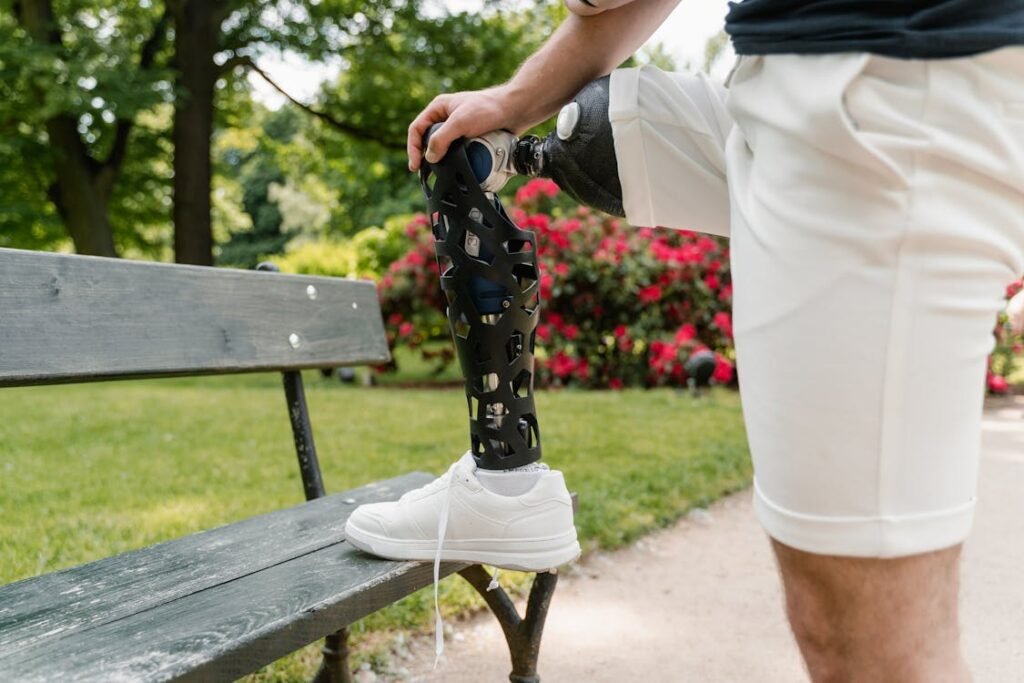
Beyond Competition: How Paralympic Athletes Are Inspiring a New Generation
Paralympic athletes are not just breaking records—they are changing perceptions, inspiring millions, and proving that physical limitations do not define human potential.
Their impact goes far beyond the track, pool, or court, influencing society, technology, and the future of sports for people with disabilities.
Shifting the Global Perception of Disability
For years, people with disabilities were often viewed through the lens of limitations rather than potential.
The rise of Paralympic athletes on the global stage has helped shift this perspective, showing the world that adaptive sports are just as competitive, thrilling, and demanding as any other sport.
Through their achievements, Paralympians demonstrate that disability is not a barrier—it’s a challenge to be overcome with training, innovation, and resilience.
Their success stories challenge stereotypes and encourage greater inclusion in schools, workplaces, and athletic programs.
Many of these athletes become public speakers, mentors, and advocates, using their platforms to promote equality, accessibility, and representation in all areas of life.
Expanding Opportunities for Amputee Athletes
As Paralympians continue to inspire the world, more opportunities are opening up for aspiring athletes with limb loss. What was once considered an elite, inaccessible field is now growing into a wider movement, making sports more inclusive for everyone.
Adaptive sports programs, youth leagues, and community-based training centers are now available in more countries, providing access to prosthetic technology, coaching, and structured athletic development.
Schools and universities are also recognizing the importance of adaptive athletics, offering more scholarships and funding for student-athletes with disabilities.
With the increasing affordability and accessibility of sports prosthetics, more individuals are now able to pursue competitive sports at regional, national, and international levels.
The rise of social media has also allowed athletes to share their journeys, connecting with a global audience and motivating others to take up sports despite their physical challenges.
The Role of Paralympians in Driving Policy and Inclusion
Beyond sports, Paralympic athletes are influencing policy changes that benefit people with disabilities in everyday life. Their visibility has led to stronger advocacy for better prosthetic funding, improved accessibility in public spaces, and more inclusive employment opportunities.
Some Paralympic champions work directly with government agencies and prosthetic manufacturers to ensure that high-quality prosthetic limbs are not just reserved for elite athletes but are available to anyone who needs them.
Their experiences serve as real-world case studies that help shape future prosthetic designs, healthcare policies, and rehabilitation programs.
At Robobionics, we believe that sports prosthetics should be available to every individual who dreams of competing, training, or simply enjoying movement.
Our goal is to support athletes at every level, ensuring that they have access to the technology and guidance needed to excel. If you are looking for a customized sports prosthetic that matches your ambitions, contact us today and take the first step toward achieving your goals.
Conclusion
Paralympic athletes are proving that disability is not a limitation—it is an opportunity to innovate, adapt, and push the boundaries of human performance. With cutting-edge sports prosthetics, they are sprinting faster, jumping higher, and competing at levels once thought impossible. Through their dedication, they are not only redefining elite athletics but also inspiring a new generation of amputee athletes and driving advancements in prosthetic technology.
Beyond competition, Paralympians are changing perceptions about disability, inclusion, and accessibility. Their success is leading to better prosthetic designs, greater support for adaptive sports, and more opportunities for athletes with limb loss. The combination of science, engineering, and human determination continues to reshape what is possible in sports and beyond.
At Robobionics, we are committed to supporting this movement by providing high-performance, customized sports prosthetics designed for every level of athlete. If you are looking to maximize your potential and take your athletic journey to the next level, contact us today and discover how the right prosthetic can help you achieve your dreams.



